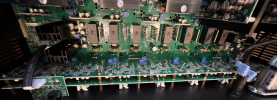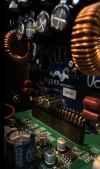HaveMeterWillTravel
Senior Member
Recently I helped a family friend who wanted to upgrade and consolidate his 7.1 home theater amplifiers which is a collection of 4 different '80s vintage stereo amplifiers.
He had budgeted around $3500 and wanted at least his current 250W to his LR and all his speakers are 8Ω.
We started off looking at the NAD M28 but were not able to find any used in good condition (new is $5500). He liked the Apollon but did not want an international buy.
I stumbled across a local used McIntosh MI347 listed at $3000 which fit the bill. We went over to look at it and it was pretty much brand new. I think it was "buyers remorse" as the guys other equipment most were 70s vintage. During the quick negotiations my friend mentioned he was replacing his Hafler factory DH-500 and DH-200 which he had "upgraded" about a decade ago.
The sellers face immediately lit up and started asking all kinds of questions about them and my friend invited him to come over and look at them. They ended up swapping amps and $1k which I think was an unbelievable deal for my friend.
Anyways, I opened up the MI347 for a quick look and took some photographs.
Here are my thoughts:
It has 7 Channels, 3 of which are rated at 250W @ 8Ω, the other 4 are 125W @ 8Ω. Both at 0.025% THD with a S/N of -100dB.
Overall, the build quality is pretty good though some part selections are clearly to a price point. The aesthetics are a nice blend of the classic McIntosh lite logo and a modern look.
I highly doubt there would be any audible degradation now but only time will tell, especially on the main power and channel output filter caps. However, if they made all their signal I/O PCBs more modular for their class-D amplifiers they may have been able to achieve the same price point with more premium capacitors.
Comments/Critiques:
From an EMC perspective the selected CorCom EMI filter is rather meh spec wise, but better than nothing.
My main complaint is how they ran the line power. It is in close proximity to the line level signals for the left front and center channels.
By having a separate fuse holder they have also created an open loop area between the line and neutral wires. Current flow will induce a larger magnetic field which can couple onto those channels. I would expect if tested one would see a higher amplitude of power line harmonics on these two channels than the rest.
Again, I double it would be audible but it's an unforced error. They should have used an AC outlet/filter with integrated fuses to avoid the situation.
Line power is routed to a sub-board which has additional filtering, 'standby power', and two relay which are timer delayed to supply line power to two separate AC to DC power boards.
The AC to DC boards are rather large. The line side uses mostly Jianghai caps. Out of the Chinese capacitor manufactures they seem to be one of the better ones. Still, given the market McIntosh typically sells to I was a little surprised to see them.
The DC side of the board appears to be Nichicon.
Both the signal I/O PCB and the main board were custom designed/made for the 7 channels and amp module selected. There is nothing wrong with this, however I would have expected a more modular design where they could more easily scale up or down the number of channels.
It uses OPA2134 in the main signal path.
Three HyperX NC500OEM are used for three LCR channels. They appear to be the "normal" version and predominately use Samwha caps.
Four HyperX UcD102 modules, each bridged are used for the remaining four channels. Visually they seem identicle to the NAD "blue pcb" modules.
McIntosh MI347
7 Channel, 3x250W 8Ω, 4x125W 4Ω.
Overall, the build quality is pretty good though some part selections are clearly to a price point.
I highly doubt there would be any audible degradation now but only time will tell, especially on the main power and channel output filter caps. However, if they made all their signal I/O PCBs more modular for their class-D amplifiers they may have been able to achieve the same price point with more premium capacitors. At least they appear to be all 105c rated.
Critiques:
From an EMC perspective the selected CorCom EMI filter is rather meh spec wise, but better than nothing.
My main complaint is how they ran the line power. It is in close proximity to the line level signals for the left front and center channels.
By having a separate fuse holder they have also created an open loop area between the line and neutral wires. Current flow will induce a larger magnetic field which can couple onto those channels. I would expect if tested one would see a higher amplitude of power line harmonics on these two channels than the rest.
Again, I double it would be audible but it's an unforced error. They should have used an AC outlet/filter with integrated fuses to avoid the situation.
Line power is routed to a sub-board which has additional filtering, 'standby power', and two relay which are timer delayed to supply line power to two separate AC to DC power boards. There appears to be no EFT/surge protection.
The AC to DC boards are rather large. The line side uses mostly Jianghai/JH caps. Out of the Chinese capacitor manufactures they seem to be one of the better ones. Still, given the market McIntosh typically sells to I was a little surprised to see them. The DC side of the board appears to be Nichicon.
Both the signal I/O PCB and the main board were custom designed/made for the 7 channels and amp module selected. There is nothing wrong with this, however I would have expected a more modular design where they could more easily scale up or down the number of channels.
It uses OPA2134 in the main signal path.
Three HyperX NC500OEM are used for three LCR channels. They appear to be the "normal" version and predominately use Samwha caps. Again, even thou it most likely would not affect measurements, I would have expected McIntosh to substitute in a "name brand" cap.
Four HyperX UcD102 modules, each bridged are used for the remaining four channels. Visually they seem identical to the NAD "blue pcb" modules. I was not able to position my phone to see which brand the caps are.
Image courtesy of McIntosh
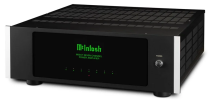
Image courtesy of McIntosh
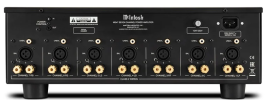
Interior view
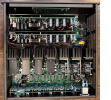
Back plane and main board
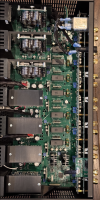
AC to DC SMPSs (2)
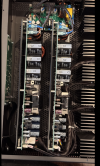
LCR channels - 3x HyperX NC500OEM
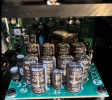
4 surround channels - 4x HyperX UcD102 modules
He had budgeted around $3500 and wanted at least his current 250W to his LR and all his speakers are 8Ω.
We started off looking at the NAD M28 but were not able to find any used in good condition (new is $5500). He liked the Apollon but did not want an international buy.
I stumbled across a local used McIntosh MI347 listed at $3000 which fit the bill. We went over to look at it and it was pretty much brand new. I think it was "buyers remorse" as the guys other equipment most were 70s vintage. During the quick negotiations my friend mentioned he was replacing his Hafler factory DH-500 and DH-200 which he had "upgraded" about a decade ago.
The sellers face immediately lit up and started asking all kinds of questions about them and my friend invited him to come over and look at them. They ended up swapping amps and $1k which I think was an unbelievable deal for my friend.
Anyways, I opened up the MI347 for a quick look and took some photographs.
Here are my thoughts:
It has 7 Channels, 3 of which are rated at 250W @ 8Ω, the other 4 are 125W @ 8Ω. Both at 0.025% THD with a S/N of -100dB.
Overall, the build quality is pretty good though some part selections are clearly to a price point. The aesthetics are a nice blend of the classic McIntosh lite logo and a modern look.
I highly doubt there would be any audible degradation now but only time will tell, especially on the main power and channel output filter caps. However, if they made all their signal I/O PCBs more modular for their class-D amplifiers they may have been able to achieve the same price point with more premium capacitors.
Comments/Critiques:
From an EMC perspective the selected CorCom EMI filter is rather meh spec wise, but better than nothing.
My main complaint is how they ran the line power. It is in close proximity to the line level signals for the left front and center channels.
By having a separate fuse holder they have also created an open loop area between the line and neutral wires. Current flow will induce a larger magnetic field which can couple onto those channels. I would expect if tested one would see a higher amplitude of power line harmonics on these two channels than the rest.
Again, I double it would be audible but it's an unforced error. They should have used an AC outlet/filter with integrated fuses to avoid the situation.
Line power is routed to a sub-board which has additional filtering, 'standby power', and two relay which are timer delayed to supply line power to two separate AC to DC power boards.
The AC to DC boards are rather large. The line side uses mostly Jianghai caps. Out of the Chinese capacitor manufactures they seem to be one of the better ones. Still, given the market McIntosh typically sells to I was a little surprised to see them.
The DC side of the board appears to be Nichicon.
Both the signal I/O PCB and the main board were custom designed/made for the 7 channels and amp module selected. There is nothing wrong with this, however I would have expected a more modular design where they could more easily scale up or down the number of channels.
It uses OPA2134 in the main signal path.
Three HyperX NC500OEM are used for three LCR channels. They appear to be the "normal" version and predominately use Samwha caps.
Four HyperX UcD102 modules, each bridged are used for the remaining four channels. Visually they seem identicle to the NAD "blue pcb" modules.
McIntosh MI347
7 Channel, 3x250W 8Ω, 4x125W 4Ω.
Overall, the build quality is pretty good though some part selections are clearly to a price point.
I highly doubt there would be any audible degradation now but only time will tell, especially on the main power and channel output filter caps. However, if they made all their signal I/O PCBs more modular for their class-D amplifiers they may have been able to achieve the same price point with more premium capacitors. At least they appear to be all 105c rated.
Critiques:
From an EMC perspective the selected CorCom EMI filter is rather meh spec wise, but better than nothing.
My main complaint is how they ran the line power. It is in close proximity to the line level signals for the left front and center channels.
By having a separate fuse holder they have also created an open loop area between the line and neutral wires. Current flow will induce a larger magnetic field which can couple onto those channels. I would expect if tested one would see a higher amplitude of power line harmonics on these two channels than the rest.
Again, I double it would be audible but it's an unforced error. They should have used an AC outlet/filter with integrated fuses to avoid the situation.
Line power is routed to a sub-board which has additional filtering, 'standby power', and two relay which are timer delayed to supply line power to two separate AC to DC power boards. There appears to be no EFT/surge protection.
The AC to DC boards are rather large. The line side uses mostly Jianghai/JH caps. Out of the Chinese capacitor manufactures they seem to be one of the better ones. Still, given the market McIntosh typically sells to I was a little surprised to see them. The DC side of the board appears to be Nichicon.
Both the signal I/O PCB and the main board were custom designed/made for the 7 channels and amp module selected. There is nothing wrong with this, however I would have expected a more modular design where they could more easily scale up or down the number of channels.
It uses OPA2134 in the main signal path.
Three HyperX NC500OEM are used for three LCR channels. They appear to be the "normal" version and predominately use Samwha caps. Again, even thou it most likely would not affect measurements, I would have expected McIntosh to substitute in a "name brand" cap.
Four HyperX UcD102 modules, each bridged are used for the remaining four channels. Visually they seem identical to the NAD "blue pcb" modules. I was not able to position my phone to see which brand the caps are.
Image courtesy of McIntosh

Image courtesy of McIntosh

Interior view

Back plane and main board

AC to DC SMPSs (2)

LCR channels - 3x HyperX NC500OEM

4 surround channels - 4x HyperX UcD102 modules
